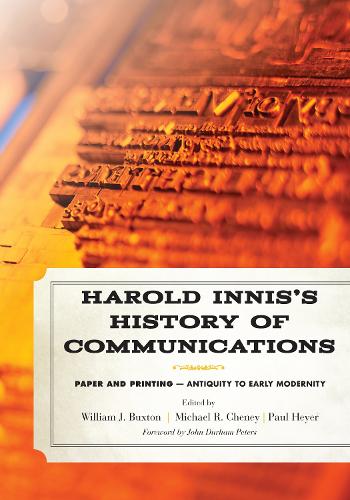
Harold Innis's History of Communications: Paper and PrintingAntiquity to Early Modernity
(Hardback)
Publishing Details
Harold Innis's History of Communications: Paper and PrintingAntiquity to Early Modernity
By (Author) William J. Buxton
Edited by Michael R. Cheney
Edited by Paul Heyer
Foreword by John Durham Peters
Bloomsbury Publishing PLC
Rowman & Littlefield Publishers
18th December 2014
United States
Classifications
Professional and Scholarly
Non Fiction
Social and cultural history
302.209
Physical Properties
Hardback
200
Width 186mm, Height 263mm, Spine 18mm
590g
Description
For decades, media historians have heard of Harold Inniss unpublished manuscript exploring the history of communicationsbut very few have had an opportunity to see it. In this volume, editors and Innis scholars William J. Buxton, Michael R. Cheney, and Paul Heyer make widely accessible, for the first time, three core chapters from the legendary Innis manuscript. Here, Innis (1894-1952) examines the development of paper and printing from antiquity in Asia through to 16th century Europe. He demonstrates how the paper/printing nexus intersected with a broad range of other phenomena, including administrative structures, geopolitics, militarism, public opinion, aesthetics, cultural diffusion, religion, education, reception, production processes, technology, labor relations, and commerce, as well as the lives of visionary figures. Buxton, Cheney, and Heyer knit the chapters into a cohesive narrative and help readers navigate Inniss observations by summarizing the heavily detailed factual material that peppered the unpublished manuscript. They provide further context for Inniss arguments by adding annotations, references, and pertinent citations to his other writings. The end result is both a testament to Inniss status as a canonical figure in the study of communication and a surprisingly relevant contribution to how we might think about the current sea change in all aspects of social, cultural, political, and economic life stemming from the global shift to digital communication.
Reviews
This is a very lightly edited version of three chapters of Harold Innis's vast, unpublished, fact-packed manuscript on the history of communications. Innis (18941952) was a major 20th-century economic historian, known for his 'staple theory' of Canadian economic development. Fewer people know that in the last decade of his life, he pursued a study of the history of the pulp-and-paper industry that involved researching the history of humankind's communication activities back to ancient times. Materials (paper), technologies (printing), and the effects of communication (advertising) on society are what interested him. Presented here are the 'Coming of Paper' and chapters on 15th- and 16th-century printingwork the editors thought would interest today's scholars of book history. The content represents material that is not well reflected in Innis's Empire and Communications (1950), The Bias of Communication (1951), and Changing Concepts of Time (1952). The editors are professors of communication studies and economics in the US and Canada. Their added notes cover some of the work done since 1952 on the history of printed communications that is not reflected here. . . .Summing Up: Recommended. Upper-level undergraduates through researchers/faculty. * CHOICE *
Here at last,Harold Innis's History of Communicationis a masterful rendering of many of the unpublished writings by the man who inspired Marshall McLuhan and taught us to look at the material and organizational infrastructure of communication media as foundational to manners of thought and the natures of civilizations. Compiled and edited by three of Canada's foremost communications historians, Buxton, Cheney and Heyer have pulled together some exciting, mind-morphing stuff! -- Rowland Lorimer, Simon Fraser University
Scholars and students of communication owe Buxton, Cheney, and Heyer an enormous debt. Their rigorous editing of previously unpublished chapters from Inniss history of communications brings to the public extraordinary examples of his brilliant research and his groundbreaking conceptualization of communication. It is mandatory reading, essential as we address the dominance of digital communication in the twenty-first century. -- Robert W. McChesney, author, Blowing the Roof Off the Twenty-First Century: Media, Politics, and the Struggle
We are fortunate to finally be able to read core chapters from Harold Innis' legendary unpublished history of communication thanks to the work of Buxton, Cheney, and Heyer. Ranging widely across time and space, Innis presents a kaleidoscopic portrait of the various surfaces, writing systems, and practices that have shaped human communication. Framed by the authors' excellent introduction, this book offers a fascinating new perspective on the linkages between material and cultural history that Innis was making in his later work. -- Michael Stamm, Michigan State University
Author Bio
William J. Buxton is professor of communication studies at Concordia University in Montreal; his numerous publications include Talcott Parsons and the Capitalist Nation-State, Harold Innis in the New Century, and Harold Innis and the North. Michael R. Cheney is professor of communication and associate professor of economics at the University of Illinois Springfield. He served as inaugural editor for the Journal of Media Sociology and publishes on politics, culture, and technology. Paul Heyer is professor of communication studies at Wilfrid Laurier University. His publications include Communication and History, Titanic Century, and Harold Innis.
